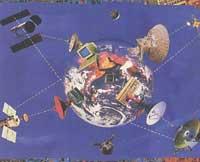Information and environmental technologies
Information technology companies, both hardware manufacturers and software developers or service providers, play a key role in environmental protection activities and policies, although this is often unknown to the public.
Where does the contribution of companies in the sector come from? Obviously, of the measures they take to minimize their impact on the environment, but it may be more important their contribution to maintaining the resources of our planet with its products.
New information technologies are driving the deployment of services such as teleconference and telework, which will result in a significant reduction in the use of travel and transport, contributing to energy savings and reducing environmental pollution. And certainly our planet needs it.
The oil crisis, which took place in 1978, increased travel costs by 40%, which multiplied between 1980 and 82 and increased from 10 to 20% in the following years. Today, 38% of business trips are interbusiness. 50% have a single goal and between 25 and 15% of them could be done by teleconference. In the most unfavorable case, the replacement of 15% would mean annual savings of 10.8 billion dollars, according to a study conducted at the Stanford Research Institute: This would save 80,000 barrels of fuel reactor and 110,000 barrels of car gasoline.
Whether the teleconference contribution is important. The conclusions of telework will also be taken into account, as can be seen in the results of a study by the US Department of Transport.

According to these data, in 1992 in the US there were 2 million teleworkers (1.6% of the workforce) and the forecast for 1997 is 6 million (4.6% of the workforce). The incidence of this fact on energy consumption and the environment is shown in the following table.
In addition to those already mentioned, there are more changes that information technologies will entail. Due to its strong impact on the environment, the reduction in the use of new technologies in paper consumption is noteworthy. Currently in the world 120,000 million A4 pages are printed annually: This is equivalent to 9 million trees or a 450 km2 grove.
The electronic file system, email and the electronic data exchange system EDI offer us resources to give a suitable solution to this situation, for example, to make a commercial transaction of any economic sector, it is necessary an average role of 5 to 12, in about 30 cases; as is known, the IME completely avoids this paper exchange. On the other hand, one of the optical discs currently on the market has a storage capacity of 36,000 A4 pages. The use of a disc saves 8 m in height and 2.5 trees 14 cm in diameter.
The examples we have put confirm that Information Technologies allow us to save resources. In any case, we must not forget the effort being made in the companies producing these technologies themselves, in order to minimize the impact that is generated in them.
From this point of view it is worth highlighting:
- Total elimination of CFCs and use of alternative solvents in manufacturing processes for cleaning, without triclotoethane 1.1.
- Miniaturization has made products smaller and smaller, so steps are being taken to reduce raw materials.
- The removal of glues and railings in the new packaging, the replacement of plastic emollients of polystyrene by other plastic to protect them from impact, by cardboard that the packaging itself is totally recyclable, thus achieving compliance with the standard 94/62 CE of packaging and waste.
And of course, a greater concern for the environment has also come from technological development. For example, the keyboards use laser printing systems that prevent the use of the ink, or the parts of the computer that are unrecyclable are already biodegradable plastic, as well as the so-called “green computers”, which include new microprocessors (which feed 5 to 3.3 V or less) and stand-by systems that reduce consumption by 90%. These new computers will save 57% on energy consumption by the year 2000, which means an equivalent contribution to the elimination of 5 million cars a year until the year 2000 (US figures, results of the study carried out by the local Environment Protection Agency).
All this shows us that the IT sector has made its environmental goals its own and is working on this commitment. It will be a pioneering sector that will advance in the different norms of the European Union.
This new situation will entail important changes in the industrial and commercial structure, in the consumption habits of all of us and in the selection of suppliers.
Influence of telework on transport |
Teleworkers 1992 (USA) |
Teletrabajadores 1997 (USA) |
Gasoline savings Emissions savings of Million |
178% |
|





